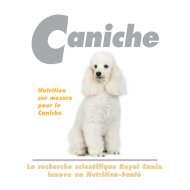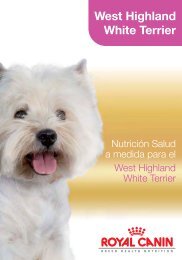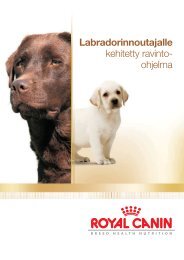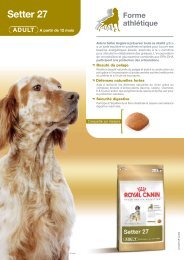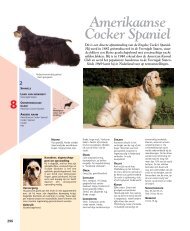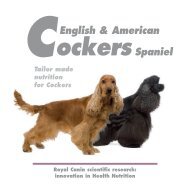Specific breed brochure - Breed Nutrition
Specific breed brochure - Breed Nutrition
Specific breed brochure - Breed Nutrition
You also want an ePaper? Increase the reach of your titles
YUMPU automatically turns print PDFs into web optimized ePapers that Google loves.
Strong jaws and teeth<br />
Ingestion and digestion are connected<br />
Among the factors causing gastric dilatation-volvulus (GDV) – also known as bloat and torsion –<br />
are small kibbles and rapid ingestion (Glickman et al, 1994; Raghavan et al, 2004). As with all<br />
large dogs, the risk of GDV in Rottweilers is not to be brushed aside, although the likelihood of it<br />
occurring remains relatively low compared with<br />
other giant <strong>breed</strong>s. According to Ward et al<br />
(2003), 3.9% of individuals will suffer from<br />
the problem some time in their life.<br />
Dilatation occurs when the sphincter at the<br />
end of the stomach, the pylorus, does not<br />
allow the stomach to empty normally. This is<br />
quickly aggravated by the accumulation of gas<br />
emitted from the stomach contents and air ingested<br />
by the dog as it unsuccessfully tries to vomit. It<br />
can be followed by the rotation of the stomach,<br />
which is facilitated by the laxity in the way the stomach<br />
is attached in the abdomen. This disrupts<br />
local circulation, lowers blood pressure and provokes<br />
a sudden state of shock. If surgery is not performed<br />
in time GDV can be fatal.<br />
This means it is essential to take account of the anatomical<br />
characteristics of the Rottweiler’s teeth and<br />
jaws to ensure the dog is given a food that encourages<br />
it to chew and prevents it from sucking a<br />
large quantity of air in with its food.<br />
13<br />
© J.-M. Labat



